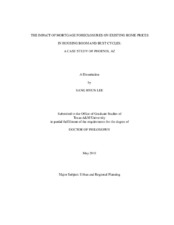| dc.contributor.advisor | Saginor, Jesse | |
| dc.creator | Lee, Sang Hyun | |
| dc.date.accessioned | 2012-07-16T15:57:20Z | |
| dc.date.accessioned | 2012-07-16T20:30:50Z | |
| dc.date.available | 2012-07-16T15:57:20Z | |
| dc.date.available | 2012-07-16T20:30:50Z | |
| dc.date.created | 2011-05 | |
| dc.date.issued | 2012-07-16 | |
| dc.date.submitted | May 2011 | |
| dc.identifier.uri | https://hdl.handle.net/1969.1/ETD-TAMU-2011-05-9457 | |
| dc.description.abstract | Many communities around the country had already been dealing with the problems of increasing and concentrated foreclosures for several years. Thus, the evidence of the social costs of foreclosures will guide policy makers in deciding what policies should be put in many communities that foreclosures have plagued. The objective of this research is to quantify the price-depressing foreclosure effects on existing home sale prices as one of the major social costs for communities. The first methodological goal is to simultaneously quantify the magnitude of the direct and the spillover effects of foreclosures on existing home prices. The second methodological goal is to provide usefulness concerning spatial econometric models in measuring the impact of foreclosures on housing prices.
This study was estimated with traditional hedonic and spatial hedonic models specified during two different housing cycles in Phoenix, Arizona, during a strong housing market when prices were up (2005) and a down housing market with falling prices (2008). It has been shown that foreclosures have negative effects on existing home prices in the neighborhood, depending on housing types and cycles. However, the OLS models do not correct for spatial autocorrelation problems and endogeneity that exist in a cross section of house prices and would overestimate absolute values of the coefficients. As alternatives, the maximum likelihood spatial lag or error model controls for spatial autocorrelation but still causes computation obstacles for large data sets and problems of heteroskedasticity in error terms. Thus, the preferred specification is a generalized method of moments (GMM) approach which requires weaker assumptions than the maximum likelihood application and has flexible form to large datasets. As a joint analysis, the most appropriate specification is the general spatial two-stage least-squares (GMM_2SLS) method with HAC (the spatial heteroskedasticity and autocorrelation consistent) variance estimator.
These findings provide further evidence that OLS estimates of a coefficient on a foreclosure indicator tend to overstate the direct or indirect foreclosure discount, ignoring spatial effects such as spatial dependence and endogeneity.
With regard to the spillover effect of nearby foreclosures on home prices, both foreclosures of single family homes and condos are statistically significant and negatively impact each type of home sale prices. However, the cumulative effects of neighborhood foreclosures are much greater with nonlinear effects in a housing bust year than a housing boom year. Therefore, this study on price-depressing effects of foreclosures emphasizes the importance of the pre-foreclosure step as the beginning of following foreclosure processes, depending on housing types and housing market cycles. | en |
| dc.format.mimetype | application/pdf | |
| dc.language.iso | en_US | |
| dc.subject | Foreclosures | en |
| dc.subject | Spillover Effects | en |
| dc.subject | Home Sale Prices | en |
| dc.subject | Spatial Effects | en |
| dc.title | The Impact of Mortgage Foreclosures on Existing Home Prices in Housing Boom and Bust Cycles: A Case Study of Phoenix, AZ | en |
| dc.type | Thesis | en |
| thesis.degree.department | Landscape Architecture and Urban Planning | en |
| thesis.degree.discipline | Urban and Regional Planning | en |
| thesis.degree.grantor | Texas A&M University | en |
| thesis.degree.name | Doctor of Philosophy | en |
| thesis.degree.level | Doctoral | en |
| dc.contributor.committeeMember | Van Zandt, Shannon S. | |
| dc.contributor.committeeMember | Choudhury, Iftekharuddin | |
| dc.contributor.committeeMember | Anderson, Sammy K. | |
| dc.type.genre | thesis | en |
| dc.type.material | text | en |


